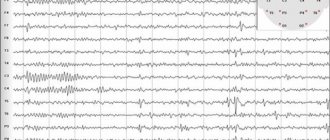Everyone in their circle of friends has a person who constantly complains about their health: they have a stabbing pain, they are sick, or they simply don’t feel well. But no matter how many times he goes to doctors, no one finds a specific reason for this condition. He’s pretending, we think. But don't rush to conclusions. These symptoms may be a sign of a somatoform nervous system disorder. It does not have an organic background, but leads to a mental imbalance of the individual.
Development mechanism
The autonomic department of the nervous system regulates the functioning of all internal organs. In addition, it controls many physiological processes. If the autonomic nervous system functions normally, the internal organs work harmoniously, promptly ensuring their adaptation to constantly changing conditions. For example, this department regulates breathing and the frequency of contractions of the heart muscle, heat exchange.
Like the central nervous system, the autonomic region is represented by a system of neurons. These are cells that have a complex structure and perform many functions. Under the influence of various provoking factors, a disorder of the autonomic (vegetative) nervous system can develop. In such cases, the patient’s general condition worsens significantly, as the functioning of most internal organs is disrupted.
Causes
Disorders of the autonomic (autonomic) nervous system are divided into the following types:
- Somatoform. This is the disorder that is easiest to treat. It develops against the background of chronic stress in a person. The somatoform type of disorder is a type of neurosis. The difficulty of diagnosing it lies in the fact that the symptoms of the disease manifest themselves in the form of signs of various pathologies of a chronic nature, which a person actually does not have.
- Damage to subcortical structures. The main causes of the disorder are brain injuries and residual disease of the central nervous system. The disorder manifests itself in the form of an attack, after which the person feels severe lethargy and weakness.
- Continuous irritation of peripheral autonomic structures. Occurs with urolithiasis, PMS and cervical dorsopathy.
The code for the above disorders in ICD-10 is G90 “Disorders of the autonomic (autonomic) nervous system. In some cases, it is not possible to identify the true cause of the disease. In such situations, it is customary to talk about an unspecified disorder of the autonomic nervous system. The code for such a pathology in ICD-10 is G90.9.
Provoking factors for the development of disorders are the following conditions:
- Prolonged stay in a state of stress.
- Genetic predisposition.
- Hormonal imbalance (including those associated with natural age-related changes in the body).
- A lifestyle that does not involve regular physical activity.
- Unbalanced diet, excessive consumption of fatty and fried foods, fast food.
- Tobacco smoking.
- Regular consumption of alcoholic beverages.
- Violation of the integrity of nerve fibers resulting from trauma, injury and after surgery.
- Intoxication of the body.
- Long-term and especially uncontrolled use of medications.
- Allergic reactions.
It is important to know that a disorder of the autonomic nervous system of any type is one of the manifestations of an existing serious disease. It is not recommended to self-medicate; only a doctor can determine the true cause of the disorder and correctly draw up a treatment regimen.
Peripheral autonomic failure: symptoms
In each individual patient, the set of symptoms demonstrated is different from the symptoms demonstrated by other patients. However, in the clinical picture of peripheral autonomic failure, the following signs are the typical, most common signs.
The leading symptom of the primary form of PVN is orthostatic (postural) hypotension. This condition is characterized by an excessive decrease in blood pressure when a person stands up and assumes an upright position. At the same time, the person feels weak and dizzy. Disorientation in time and space may occur. Possibly a reversible decrease in visual acuity. Such phenomena continue for up to several minutes if the subject is in an upright position. Signs of orthostatic hypotension quickly disappear when the position is changed to a horizontal position. Some patients experience syncope - a temporary loss of consciousness. In severe cases of the disease, fainting may occur if the person is in a sitting position. The patient may indicate weakness that has gripped him, the appearance of fog before his eyes, the occurrence of noise and ringing in the head, the feeling that “the ground is leaving from under his feet.” If the fainting state continues for more than ten seconds, then tonic convulsions and tongue biting may develop. Severe circulatory disorders characteristic of postural hypotension can cause premature death.
The second most common sign of PVN is tachycardia without exercise - an increase in the number of heart contractions while at rest. Due to the instability of the heart rhythm, this phenomenon was called “rigid pulse”. A patient with peripheral autonomic failure syndrome does not experience adequate changes in heart rate when performing physical activity. Increased heart rate is more often detected in adolescents and young adults, and tachycardia is recorded more often in women than in the stronger sex. When trying to get up, a person may feel chills, trembling in the body, anxiety, and breathing problems.
Due to the characteristics of this syndrome, in particular: due to damage to visceral fibers, in patients with a secondary form of PVN, acute damage to the heart muscle can occur without the development of pain. The painless course of myocardial infarction, characteristic of diabetes mellitus, is the leading cause of spontaneous death.
Along with a decrease in pressure in peripheral autonomic failure, arterial hypertension is often observed - an increase in blood pressure when a person is in a supine position. During night rest or during daytime leisure hours spent lying down, a person experiences critically high blood pressure values. This clinical feature of PVN, namely the likelihood of the transition of orthostatic hypotension to arterial hypertension, requires an extremely cautious approach when choosing medications that work to increase blood pressure.
The fourth symptom of peripheral autonomic failure is hypohidrosis or the opposite phenomenon - agnidrosis. As a rule, a person does not pay attention to the presence of reduced sweating, so this anomaly can often be detected during a lengthy medical examination. Also, the detected increased sweating along with the presence of orthostatic hypotension gives every reason to assume the presence of PVN syndrome.
The next group of signs of peripheral autonomic failure is represented by disorders of the digestive tract. In patients, disturbances in the motor activity of the stomach are determined - paresis. The symptom complex manifests itself with nausea and vomiting, a feeling of a “full stomach.” Constipation or diarrhea, as a rule, is paroxysmal in nature. Patients may have a complete lack of appetite.
Another symptom of PVS syndrome is bladder dysfunction. This anomaly is manifested by the loss of the ability to control urination. A person experiences difficulty in passing urine. Large gaps appear between acts of urination, which leads to bladder overflow. Against the background of such phenomena, a secondary infection may develop in the genitourinary system.
With peripheral autonomic failure, impotence is also observed, which is not psychogenic in nature. Men note a decrease in erection and the release of sperm towards the bladder instead of the release of seminal fluid through the urethra. Women identify a lack of hydration of the vaginal mucosa during arousal and a decrease in clitoral sensitivity.
Respiratory disorders in the structure of the PVN syndrome are represented by the following symptoms: short-term cessation of breathing, apnea at night, spontaneously occurring episodes of suffocation. If cardiovascular reflexes are impaired, respiratory dysfunction can cause sudden death.
Other symptoms of PVN syndrome include:
- xerophthalmia – dry eyes;
- xerostomia – dry mouth;
- vasoconstriction - narrowing of the lumen of the arteries;
- vasodilation - an increase in the lumen of blood vessels;
- swelling of the distal parts of the body;
- peripheral edema;
- miosis - constriction of the pupils;
- decreased ability to see in the dark;
- decreased pupillary response to light.
Clinical manifestations
Disorders of the autonomic (autonomic) nervous system (including unspecified) do not have specific symptoms. Most people mistake the discomfort that arises for manifestations of existing diseases.
The main types of symptoms of a disorder of the autonomic (autonomic) nervous system are as follows:
- Cardiovascular syndrome. Includes sudden jumps in blood pressure, impaired peripheral circulation, sudden discomfort in the heart area and disruption of the rhythm of this muscle.
- Hyperventilation syndrome. The patient experiences rapid breathing, muscle spasms, and a faint state. It's as if the person doesn't have enough air. He also complains of partial loss of sensation in his limbs.
- Irritable bowel syndrome. Includes episodes of diarrhea, frequent urge to defecate, flatulence, muscle spasms, and pain in the lower abdomen.
In addition, the following conditions are symptoms of the pathology:
- Nausea, often turning into vomiting.
- Feeling of a lump in the throat, making it difficult to swallow food.
- Discomfort in the epigastric region.
- Appetite disorders.
- Frequent episodes of painful urine discharge that are not a consequence of diseases of the genitourinary system.
- Sexual disorders. In men, both erection and ejaculation are impaired. Women develop anorgasmia and vaginismus. Libido decreases in both sexes.
- Chills.
- Increased body temperature.
If these nonspecific symptoms occur, it is important to consult a doctor promptly. The specialist will make the correct diagnosis and find out the true causes of the syndrome.
Disorders of the autonomic (vegetative) nervous system can lead to complications if left untreated.
Wide range of manifestations
Manifestations of autonomic lability are associated with all areas that are controlled by the autonomic nervous system; symptoms of the condition can be varied:
- fainting and dizziness;
- increased fatigue (due to lack of adequate adjustment of heart rate relative to stress);
- increased or decreased sweating;
- headache;
- disturbances in the digestive tract, which lead to constipation, diarrhea, bloating, loss of appetite;
- difficulty urinating;
- problems in the sexual sphere (lack of erection, vaginal dryness, nonorgasmia);
- visual impairment (increased sensitivity to light, blurred vision);
- poor tolerance to cold and heat;
- sleep disorders;
- tremor;
- rapid heartbeat, lability of blood pressure;
- apathy, lethargy, weakness, constant mild malaise;
- increased irritability;
- decreased concentration;
- sudden mood swings;
- speech disorders;
- unreasonable fears, anxiety and neurotic phobias;
- pain in joints and muscles;
- dry skin;
- numbness in various parts of the body.
Individuals with vegetative lability have an increased sensitivity to mental trauma, stress, meteorological changes, and a tendency to seasickness and air sickness.
Diagnostics
Initially, it is recommended to consult a therapist. This is a general specialist who, if a disorder is suspected, will refer you to a neurologist for consultation.
It is important to remember that disruption of the autonomic nervous system does not have specific manifestations. In this regard, a comprehensive examination is necessary to make a correct diagnosis. It involves passing laboratory and instrumental tests from a gastroenterologist, cardiologist, oncologist, endocrinologist, etc.
A disorder of the autonomic (autonomic) nervous system is confirmed if diseases with similar symptoms were not identified during the diagnostic process.
Drug treatment
It is a mandatory item in the treatment regimen. Drugs should be selected by a doctor based on diagnostic results and taking into account the individual health characteristics of the patient.
Treatment of a disorder of the autonomic (autonomic) nervous system involves taking medications. which include:
- Sedative drugs. They have a calming effect. Their active components have a positive effect on the nervous system as a whole. Most often, doctors prescribe products based on valerian, hawthorn, motherwort, and St. John's wort. Trade names of the drugs: “Novo-passit”, “Stressplan”, “Persen”.
- Anxiolytic drugs. In other words, tranquilizers. Their use is especially indicated for severe disorders of the autonomic (autonomic) nervous system. The drugs help relieve the patient from causeless feelings of anxiety, severe stress and unreasonable attacks of fear. Most often doctors prescribe: Afobazol, Atarax, Seduxen, Tranxen, Stresam, Diazepam.
- Antidepressants. The purpose of taking them is to improve the degree of mental activity. Always prescribed for somatoform and other disorders of the autonomic nervous system. The active components of the drugs help eliminate feelings of apathy, depression, and anxiety. As you take it, depression subsides and your psycho-emotional state stabilizes. In addition, antidepressants are prescribed to patients suffering from chronic pain syndrome that is not amenable to symptomatic therapy. Names of drugs: Amitriptyline, Azafen, Milnacipran, Valdoxan, Prozac. In the presence of severe disorders, taking one of the following drugs is indicated: “Sulpiride”, “Teraligen”.
- Nootropics. They have a cerebroprotective effect. Prescribed to improve mental performance and increase the brain's resistance to stressful situations. In addition, while taking nootropics, the energy balance of nerve cells is normalized. As a rule, doctors prescribe: Pyritinol, Phenibut, Piracetam.
- Psychostimulants. Indicated in the presence of severe depressive states, vagotonia, hypotension, bradycardia. In most cases, doctors prefer herbal-based products, which can be combined with Duplex injections and Sidnocarb. In the presence of intracranial hypertension, Glycerol and Diacarb are additionally prescribed. In order to improve microcirculation, Cavinton, Trental and Stugeron are recommended. If necessary, calcium and potassium supplements, vitamins E and group B are prescribed.
Depending on the severity of the disease, this treatment regimen can be expanded by the doctor.
Peripheral autonomic failure: treatment
Treatment of PVN syndrome is aimed at overcoming the signs of pathology and acts as an additional component in the treatment of the underlying disease. It is worth noting that methods for treating many manifestations of peripheral autonomic failure have not been developed to date.
To eliminate orthostatic hypotension and increased blood pressure, patients are recommended to:
- drink two glasses of water at one time;
- drink a cup of freshly brewed strong tea;
- do not lie down for a long time;
- sleep with your head raised;
- limit physical activity;
- avoid sudden changes in posture;
- avoid overheating;
- stop drinking alcohol;
- increase your daily salt intake.
Pharmacological treatment of arterial hypotension includes caffeine, corticosteroids, sympathomimetics, nonsteroidal anti-inflammatory drugs, and hypertensive drugs. Tachycardia is treated with beta-blockers. To get rid of urinary disorders, depending on the symptoms demonstrated, antidiuretic hormone drugs, myotropic antispasmodics, and cholinergic drugs are used. In the treatment of digestive disorders, antiemetics, prokinetics, stimulants of tone and motility of the gastrointestinal system, anti-regurgitant and laxative drugs are used. Treatment of other signs of PVN is carried out using symptomatic agents.
In patients with peripheral autonomic failure syndrome, symptoms may regress or become aggravated. The course of most variants of PVN is progressive. The prognosis in most cases is unfavorable. Preventive measures have not been developed to date.
Other conservative treatment methods
The diagnosis of “disorder of the autonomic (autonomic) nervous system” requires an integrated approach. Taking medications is not enough to get rid of the disease.
The pathology treatment regimen also includes the following points:
- Lifestyle changes. The patient must avoid getting into stressful situations both at home and at work. It is also important to properly organize your work and rest schedule. Any overwork negatively affects the functioning of the nervous system. A person diagnosed with any type of disorder (including unspecified) is prohibited from working in emergency mode. In addition, it is necessary to make adjustments to the diet. The menu should include vegetables, fruits and protein foods. At the same time, it is advisable to exclude fatty, fried and smoked foods, easily digestible carbohydrates, carbonated drinks and alcohol from the diet. It is recommended to spend more time outdoors. The most suitable types of physical activity are yoga and swimming.
- Physiotherapy course. The goal of treatment is to eliminate muscle tension, relax the patient, and improve lymph and blood circulation. As a rule, doctors prescribe stone therapy, acupuncture, mud baths, massage and electrophoresis.
- Working with a psychologist. Consultation with a specialist is especially recommended for people suffering from workaholism. Such people are constantly in a stressful situation and are accustomed to working in emergency mode. In most cases, they ignore the first symptoms of disorders. The disorder of the autonomic (autonomic) nervous system, meanwhile, progresses and can become severe. The difficulty is that most people deny the need to see a psychologist.
Thus, to get rid of the disease, you need not only to take the medications prescribed by your doctor in a timely manner, but also to make adjustments to your lifestyle.
Treatment
Suprasegmental dysfunction of the autonomic nervous system requires an integrated approach to therapy. It is important to strictly follow all the doctor’s recommendations, even in the absence of positive dynamics. Treatment of the disease is very long and requires endurance and patience.
The classic treatment regimen consists of the following points:
- Taking medications. Any medications are prescribed exclusively on an individual basis. In case of dysfunction at the initial stage, you can do without medications at all. In other cases, doctors prescribe tranquilizers, antidepressants and beta blockers. While taking them, obsessive thoughts recede, inexplicable fear disappears, mood improves, and emotional background stabilizes. If necessary, symptomatic therapy is prescribed.
- Lifestyle changes. It is important for patients to strictly observe a daily routine and follow the principles of a healthy diet. In addition, they need to regularly expose the body to moderate physical activity and avoid getting into stressful situations.
- Psychotherapy. Many patients need to undergo treatment from a specialist to stabilize their emotional background.
- Physiotherapy. Currently, the following methods have shown the greatest effectiveness against the disease: galvanization, massage, electrophoresis, acupuncture, mineral water baths.
If necessary, the doctor can make adjustments to the treatment regimen.
Traditional methods of treatment
It is important to understand that the use of unconventional methods of therapy does not eliminate the need to seek qualified medical help. In addition, the use of any medications must be agreed upon with a doctor to prevent a decrease in the effectiveness of the medications.
For disorders of the autonomic nervous system, herbal decoctions based on St. John's wort, hawthorn, radiola and rosehip have a positive effect. They must be taken daily, 200 ml. The daily dose can be divided. The course of treatment lasts from 6 to 8 weeks. If necessary, it can be repeated after a month's break.
The course of the disease depending on age
Autonomic dysfunction syndrome is quite widespread: it occurs in more than 30% of patients who seek medical help. In children, adolescents and young adults, the incidence of this pathology is up to 30%. This is explained by hormonal changes that occur in a young body. In the older age group, the root causes of the development of autonomic disorders are considered to be chronic diseases (pancreatitis, gastric and duodenal ulcers), infectious processes, smoking and physical inactivity.
Helpful information
The spread of SVD among schoolchildren is due to the fact that during this period changes in the child’s hormonal levels occur, and all life processes intensify.
Also, the educational load, huge information flows and a sedentary lifestyle have a significant impact on the incidence of students.
If left untreated
It is important to understand that the autonomic nervous system regulates the functioning of all internal organs. If there are disturbances in its functioning, they receive irregular or completely incorrect impulses. As a result, the functioning of organs is disrupted, the immune system is significantly weakened, which threatens the development of all kinds of diseases.
In addition, ignoring the problem leads to the fact that poor health becomes a constant companion of a person. Unfounded fears begin to disturb him, and he becomes depressed. Sometimes there are attacks of a sharp deterioration in health. During this period, symptoms of myocardial infarction, migraine, osteochondrosis and a number of other diseases appear. As a result, there is a tendency towards alcoholism and suicide.
Causes of emotional lability
Emotional lability - what is it in adults and why does it occur? Emotional lability syndrome very often accompanies vascular and organic diseases of the brain and occurs in asthenic conditions. A person’s mental reaction in response to a stimulus is stimulated by the cerebral cortex. Emotional lability occurs when the nervous system is weakened. A minor irritant can provoke a lightning-fast reaction.
The following factors contribute to the development of emotional lability in adults:
- Prolonged emotional stress;
- Lack or excess of attention from others;
- Frequent stressful situations;
- Psychological trauma experienced in childhood or adulthood.
Emotional lability can develop in patients suffering from somatic diseases: pathology of the endocrine system, diseases of the reproductive system, which are accompanied by hormonal imbalance, hypovitaminosis. The cause of emotional lability may be pregnancy or menopause. In some cases, increased emotionality acts as a symptom of the following diseases:
- Malignant brain tumors;
- Atherosclerosis of cerebral vessels;
- Hypertension;
- Asthenia.
Signs of emotional lability appear in organic brain pathology and after a traumatic brain injury.
Forecast
The outcome of the disease directly depends on the timeliness of visiting a doctor. If treatment was carried out on time, the prognosis is favorable.
The doctor determines the success of treatment according to several criteria:
- The patient's headaches disappear and paroxysmal manifestations are completely stopped.
- The degree of efficiency increases.
- Mood improves, depression and inexplicable fears recede.
- Sleep is normalized.
In other words, if after treatment a person’s quality of life improves or at least returns to its previous level, the doctor considers the therapy successful. To avoid re-development of a disorder of the autonomic (autonomic) nervous system, it is necessary to follow the principles of a healthy lifestyle. It is important to eliminate the main provoking factors: stress, overwork, consumption of alcoholic beverages.
Ignoring the disease leads to the development of complications. If qualified assistance is not provided to the person at this stage, the prognosis can be considered unfavorable. If the patient has a disorder, the participation of loved ones is of great importance. As a rule, they are the ones who convince a person that seeing a doctor is vitally important.
Symptoms
Autonomic dysfunction syndrome has a polyetiological character. This explains the variability of symptoms. Symptoms of autonomic dysfunction are quite nonspecific. It is divided into 2 main groups. The first group of symptoms is characterized by the appearance of general complaints in the patient: a rise in body temperature to subfebrile levels, increased sweating, restlessness, tremor, a feeling of heartbeat.
The second group of symptoms is more specific and is characterized by complaints of dysfunction in one organ or one system.
Symptoms are often subjective and not confirmed by objective research:
- Headache, dizziness;
- Nausea;
- Bloating (flatulence);
- Dyspnea;
- Pain in the heart area;
- Vegetative crises;
- Neurogenic syncope;
- Orthostatic hypotension;
- In men - impotence;
- Angina;
- Decreased mood (hypotymia);
- Paresthesia of the upper and lower extremities (feeling of “pins and needles” crawling across the body);
- Cardiophobia (fear of death, fear of cardiac arrest);
- General weakness, decreased performance;
- Impaired urination (it may be difficult or, conversely, more frequent);
- Dissomnia disorders;
- Dysmenorrhea in women;
- Swelling of the face in the morning;
- Unpleasant sensations throughout the body.
Symptoms are combined into syndromes. Thus, the main clinical syndromes are:
- Cardialgic;
- Tachycardial;
- Asthenic;
- Astheno-neurotic;
- Hyperkinetic;
- Myocardial dystrophy syndrome;
- Respiratory distress syndrome.
The classification proposed by Nikitin and Savitsky is most widespread in clinical practice. It includes three syndromes - cardiac , hypertensive and hypotensive. This principle of dividing symptoms is based on the predominance of vagotonic or sympathicotonic manifestations.











